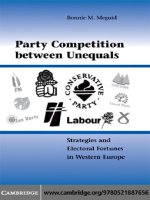cambridge university press a course in financial calculus jul 2002 kho tài liệu bách khoa
Bạn đang xem bản rút gọn của tài liệu. Xem và tải ngay bản đầy đủ của tài liệu tại đây (1.61 MB, 206 trang )
This page intentionally left blank
A Course in Financial Calculus
A Course in
Financial Calculus
Alison Etheridge
University of Oxford
CAMBRIDGE UNIVERSITY PRESS
Cambridge, New York, Melbourne, Madrid, Cape Town, Singapore, São Paulo
Cambridge University Press
The Edinburgh Building, Cambridge CB2 8RU, UK
Published in the United States of America by Cambridge University Press, New York
www.cambridge.org
Information on this title: www.cambridge.org/9780521890779
© Cambridge University Press 2002
This publication is in copyright. Subject to statutory exception and to the provision of
relevant collective licensing agreements, no reproduction of any part may take place
without the written permission of Cambridge University Press.
First published in print format 2002
eBook (EBL)
ISBN-13 978-0-511-33725-3
ISBN-10 0-511-33725-6
eBook (EBL)
ISBN-13
ISBN-10
paperback
978-0-521-89077-9
paperback
0-521-89077-2
Cambridge University Press has no responsibility for the persistence or accuracy of urls
for external or third-party internet websites referred to in this publication, and does not
guarantee that any content on such websites is, or will remain, accurate or appropriate.
Contents
Preface
page vii
1
Single period models
Summary
1.1 Some definitions from finance
1.2 Pricing a forward
1.3 The one-step binary model
1.4 A ternary model
1.5 A characterisation of no arbitrage
1.6 The risk-neutral probability measure
Exercises
1
1
1
4
6
8
9
13
18
2
Binomial trees and discrete parameter martingales
Summary
2.1 The multiperiod binary model
2.2 American options
2.3 Discrete parameter martingales and Markov processes
2.4 Some important martingale theorems
2.5 The Binomial Representation Theorem
2.6 Overture to continuous models
Exercises
21
21
21
26
28
38
43
45
47
3
Brownian motion
Summary
3.1 Definition of the process
3.2 L´evy’s construction of Brownian motion
3.3 The reflection principle and scaling
3.4 Martingales in continuous time
Exercises
51
51
51
56
59
63
67
4
Stochastic calculus
Summary
71
71
v
vi
contents
4.1
4.2
4.3
4.4
4.5
4.6
4.7
4.8
Stock prices are not differentiable
Stochastic integration
Itˆo’s formula
Integration by parts and a stochastic Fubini Theorem
The Girsanov Theorem
The Brownian Martingale Representation Theorem
Why geometric Brownian motion?
The Feynman–Kac representation
Exercises
72
74
85
93
96
100
102
102
107
5
The Black–Scholes model
Summary
5.1 The basic Black–Scholes model
5.2 Black–Scholes price and hedge for European options
5.3 Foreign exchange
5.4 Dividends
5.5 Bonds
5.6 Market price of risk
Exercises
112
112
112
118
122
126
131
132
134
6
Different payoffs
Summary
6.1 European options with discontinuous payoffs
6.2 Multistage options
6.3 Lookbacks and barriers
6.4 Asian options
6.5 American options
Exercises
139
139
139
141
144
149
150
154
7
Bigger models
Summary
7.1 General stock model
7.2 Multiple stock models
7.3 Asset prices with jumps
7.4 Model error
Exercises
159
159
160
163
175
181
185
Bibliography
Notation
Index
189
191
193
Preface
Financial mathematics provides a striking example of successful collaboration
between academia and industry. Advanced mathematical techniques, developed
in both universities and banks, have transformed the derivatives business into a
multi-trillion-dollar market. This has led to demand for highly trained students and
with that demand comes a need for textbooks.
This volume provides a first course in financial mathematics. The influence of
Financial Calculus by Martin Baxter and Andrew Rennie will be obvious. I am
extremely grateful to Martin and Andrew for their guidance and for allowing me
to use some of the material from their book.
The structure of the text largely follows Financial Calculus, but the mathematics,
especially the discussion of stochastic calculus, has been expanded to a level
appropriate to a university mathematics course and the text is supplemented by
a large number of exercises. In order to keep the course to a reasonable length,
some sacrifices have been made. Most notable is that there was not space to discuss
interest rate models, although many of the most popular ones do appear as examples
in the exercises. As partial compensation, the necessary mathematical background
for a rigorous study of interest rate models is included in Chapter 7, where we
briefly discuss some of the topics that one might hope to include in a second
course in financial mathematics. The exercises should be regarded as an integral
part of the course. Solutions to these are available to bona fide teachers from
The emphasis is on stochastic techniques, but not to the exclusion of all other
approaches. In common with practically every other book in the area, we use binomial trees to introduce the ideas of arbitrage pricing. Following Financial Calculus,
we also present discrete versions of key definitions and results on martingales and
stochastic calculus in this simple framework, where the important ideas are not
obscured by analytic technicalities. This paves the way for the more technical results
of later chapters. The connection with the partial differential equation approach to
arbitrage pricing is made through both delta-hedging arguments and the Feynman–
Kac Stochastic Representation Theorem. Whatever approach one adopts, the key
point that we wish to emphasise is that since the theory rests on the assumption of
vii
viii
preface
absence of arbitrage, hedging is vital. Our pricing formulae only make sense if there
is a ‘replicating portfolio’.
An early version of this course was originally delivered to final year undergraduate and first year graduate mathematics students in Oxford in 1997/8. Although
we assumed some familiarity with probability theory, this was not regarded as
a prerequisite and students on those courses had little difficulty picking up the
necessary concepts as we met them. Some suggestions for suitable background
reading are made in the bibliography. Since a first course can do little more than
scratch the surface of the subject, we also make suggestions for supplementary and
more advanced reading from the bewildering array of available books.
This project was supported by an EPSRC Advanced Fellowship. It is a pleasure
and a privilege to work in Magdalen College and my thanks go to the President,
Fellows, staff and students for making it such an exceptional environment. Many
people have made helpful suggestions or read early drafts of this volume. I should
especially like to thank Ben Hambly, Alex Jackson and Saurav Sen. Thanks also to
David Tranah at CUP who played a vital rˆole in shaping the project. His input has
been invaluable. Most of all, I should like to thank Lionel Mason for his constant
support and encouragement.
Alison Etheridge, June 2001
1 Single period models
Summary
In this chapter we introduce some basic definitions from finance and investigate the
problem of pricing financial instruments in the context of a very crude model. We
suppose the market to be observed at just two times: zero, when we enter into a
financial contract; and T , the time at which the contract expires. We further suppose
that the market can only be in one of a finite number of states at time T . Although
simplistic, this model reveals the importance of the central paradigm of modern
finance: the idea of a perfect hedge. It is also adequate for a preliminary discussion
of the notion of ‘complete market’ and its importance if we are to find a ‘fair’ price
for our financial contract.
The proofs in §1.5 can safely be omitted, although we shall from time to time
refer back to the statements of the results.
1.1
Some definitions from finance
Financial market instruments can be divided into two types. There are the underlying
stocks – shares, bonds, commodities, foreign currencies; and their derivatives, claims
that promise some payment or delivery in the future contingent on an underlying
stock’s behaviour. Derivatives can reduce risk – by enabling a player to fix a price
for a future transaction now – or they can magnify it. A costless contract agreeing to
pay off the difference between a stock and some agreed future price lets both sides
ride the risk inherent in owning a stock, without needing the capital to buy it outright.
The connection between the two types of instrument is sufficiently complex and
uncertain that both trade fiercely in the same market. The apparently random nature
of the underlying stocks filters through to the derivatives – they appear random
too.
Derivatives
Our central purpose is to determine how much one should be willing to pay for
a derivative security. But first we need to learn a little more of the language of
finance.
1
2
single period models
A forward contract is an agreement to buy (or sell) an asset on a
specified future date, T , for a specified price, K . The buyer is said to hold the long
position, the seller the short position.
Definition 1.1.1
Forwards are not generally traded on exchanges. It costs nothing to enter into a
forward contract. The ‘pricing problem’ for a forward is to determine what value
of K should be written into the contract. A futures contract is the same as a forward
except that futures are normally traded on exchanges and the exchange specifies
certain standard features of the contract and a particular form of settlement.
Forwards provide the simplest examples of derivative securities and the mathematics of the corresponding pricing problem will also be simple. A much richer
theory surrounds the pricing of options. An option gives the holder the right, but not
the obligation, to do something. Options come in many different guises. Black and
Scholes gained fame for pricing a European call option.
A European call option gives the holder the right, but not the
obligation, to buy an asset at a specified time, T , for a specified price, K .
A European put option gives the holder the right to sell an asset for a specified
price, K , at time T .
Definition 1.1.2
In general call refers to buying and put to selling. The term European is reserved for
options whose value to the holder at the time, T , when the contract expires depends
on the state of the market only at time T . There are other options, for example
American options or Asian options, whose payoff is contingent on the behaviour of
the underlying over the whole time interval [0, T ], but the technology of this chapter
will only allow meaningful discussion of European options.
The time, T , at which the derivative contract expires is called the
exercise date or the maturity. The price K is called the strike price.
Definition 1.1.3
The pricing
problem
So what is the pricing problem for a European call option? Suppose that a company
has to deal habitually in an intrinsically risky asset such as oil. They may for example
know that in three months time they will need a thousand barrels of crude oil. Oil
prices can fluctuate wildly, but by purchasing European call options, with strike K
say, the company knows the maximum amount of money that it will need (in three
months time) in order to buy a thousand barrels. One can think of the option as
insurance against increasing oil prices. The pricing problem is now to determine,
for given T and K , how much the company should be willing to pay for such
insurance.
For this example there is an extra complication: it costs money to store oil. To
simplify our task we are first going to price derivatives based on assets that can
be held without additional cost, typically company shares. Equally we suppose that
there is no additional benefit to holding the shares, that is no dividends are paid.
3
1.1 some definitions from finance
Payoff
K
ST
(a)
Figure 1.1
K
ST
(b)
K
ST
(c)
Payoff at maturity of (a) a forward purchase, (b) a European call and (c) a European put with
strike K as a function of ST .
Unless otherwise stated, the underlying asset can be held without
additional cost or benefit.
Assumption
This assumption will be relaxed in Chapter 5.
Suppose then that our company enters into a contract that gives them the right, but
not the obligation, to buy one unit of stock for price K in three months time. How
much should they pay for this contract?
Payoffs
As a first step, we need to know what the contract will be worth at the expiry date.
If at the time when the option expires (three months hence) the actual price of the
underlying stock is ST and ST > K then the option will be exercised. The option is
then said to be in the money: an asset worth ST can be purchased for just K . The value
to the company of the option is then (ST − K ). If, on the other hand, ST < K , then it
will be cheaper to buy the underlying stock on the open market and so the option will
not be exercised. (It is this freedom not to exercise that distinguishes options from
futures.) The option is then worthless and is said to be out of the money. (If ST = K
the option is said to be at the money.) The payoff of the option at time T is thus
(ST − K )+
max {(ST − K ), 0} .
Figure 1.1 shows the payoff at maturity of three derivative securities: a forward
purchase, a European call and a European put, each as a function of stock price at
maturity. Before embarking on the valuation at time zero of derivative contracts, we
allow ourselves a short aside.
Packages
We have presented the European call option as a means of reducing risk. Of course
it can also be used by a speculator as a bet on an increase in the stock price. In
fact by holding packages, that is combinations of the ‘vanilla’ options that we have
described so far, we can take rather complicated bets. We present just one example;
more can be found in Exercise 1.
4
single period models
Suppose that a speculator is expecting a large move
in a stock price, but does not know in which direction that move will be. Then a
possible combination is a straddle. This involves holding a European call and a
European put with the same strike price and maturity.
Example 1.1.4 (A straddle)
Explanation: The payoff of this straddle is (ST − K )+ (from the call) plus (K −
ST )+ (from the put), that is, |ST − K |. Although the payoff of this combination is
always positive, if, at the expiry time, the stock price is too close to the strike price
then the payoff will not be sufficient to offset the cost of purchasing the options and
the investor makes a loss. On the other hand, large movements in price can lead to
substantial profits.
✷
1.2
Pricing a forward
In order to solve our pricing problems, we are going to have to make some
assumptions about the way in which markets operate. To formulate these we begin
by discussing forward contracts in more detail.
Recall that a forward contract is an agreement to buy (or sell) an asset on a
specified future date for a specified price. Suppose then that I agree to buy an asset
for price K at time T . The payoff at time T is just ST − K , where ST is the actual
asset price at time T . The payoff could be positive or it could be negative and, since
the cost of entering into a forward contract is zero, this is also my total gain (or loss)
from the contract. Our problem is to determine the fair value of K .
Expectation
pricing
At the time when the contract is written, we don’t know ST , we can only guess at
it, or, more formally, assign a probability distribution to it. A widely used model
(which underlies the Black–Scholes analysis of Chapter 5) is that stock prices are
lognormally distributed. That is, there are constants ν and σ such that the logarithm
of ST /S0 (the stock price at time T divided by that at time zero, usually called the
return) is normally distributed with mean ν and variance σ 2 . In symbols:
P
ST
∈ [a, b] = P log
S0
=
log b
log a
ST
∈ [log a, log b]
S0
(x − ν)2
1
exp −
√
2σ 2
2π σ
d x.
Notice that stock prices, and therefore a and b, should be positive, so that the integral
on the right hand side is well defined.
Our first guess might be that E[ST ] should represent a fair price to write into our
contract. However, it would be a rare coincidence for this to be the market price. In
fact we’ll show that the cost of borrowing is the key to our pricing problem.
The risk-free
rate
We need a model for the time value of money: a dollar now is worth more than a
dollar promised at some later time. We assume a market for these future promises
(the bond market) in which prices are derivable from some interest rate. Specifically:
5
1.2 pricing a forward
Time value of money We assume that for any time T less than some horizon τ
the value now of a dollar promised at T is e−r T for some constant r > 0. The
rate r is then the continuously compounded interest rate for this period.
Such a market, derived from say US Government bonds, carries no risk of default –
the promise of a future dollar will always be honoured. To emphasise this we will
often refer to r as the risk-free interest rate. In this model, by buying or selling cash
bonds, investors can borrow money for the same risk-free rate of interest as they can
lend money.
Interest rate markets are not this simple in practice, but that is an issue that we
shall defer.
We now show that it is the risk-free interest rate, or equivalently the price of a cash
bond, and not our lognormal model that forces the choice of the strike price, K , upon
us in our forward contract.
Interest rates will be different for different currencies and so, for definiteness,
suppose that we are operating in the dollar market, where the (risk-free) interest rate
is r .
Arbitrage
pricing
•
•
Suppose first that K > S0 er T . The seller, obliged to deliver a unit of stock for $K at
time T , adopts the following strategy: she borrows $S0 at time zero (i.e. sells bonds
to the value $S0 ) and buys one unit of stock. At time T , she must repay $S0 er T , but
she has the stock to sell for $K , leaving her a certain profit of $(K − S0 er T ).
If K < S0 er T , then the buyer reverses the strategy. She sells a unit of stock at time
zero for $S0 and buys cash bonds. At time T , the bonds deliver $S0 er T of which she
uses $K to buy back a unit of stock leaving her with a certain profit of $(S0 er T − K ).
Unless K = S0 er T , one party is guaranteed to make a profit.
Definition 1.2.1
An opportunity to lock into a risk-free profit is called an arbitrage
opportunity.
The starting point in establishing a model in modern finance theory is to specify
that there is no arbitrage. (In fact there are people who make their living entirely
from exploiting arbitrage opportunities, but such opportunities do not exist for a
significant length of time before market prices move to eliminate them.) We have
proved the following lemma.
In the absence of arbitrage, the strike price in a forward contract
with expiry date T on a stock whose value at time zero is S0 is K = S0 er T , where r
is the risk-free rate of interest.
Lemma 1.2.2
The price S0 er T is sometimes called the arbitrage price. It is also known as the
forward price of the stock.
6
single period models
Remark: In our proof of Lemma 1.2.2, the buyer sold stock that she may not own.
This is known as short selling. This can, and does, happen: investors can ‘borrow’
stock as well as money.
✷
Of course forwards are a very special sort of derivative. The argument above won’t
tell us how to value an option, but the strategy of seeking a price that does not provide
either party with a risk-free profit will be fundamental in what follows.
Let us recap what we have done. In order to price the forward, we constructed a
portfolio, comprising one unit of underlying stock and −S0 cash bonds, whose value
at the maturity time T is exactly that of the forward contract itself. Such a portfolio is
said to be a perfect hedge or replicating portfolio. This idea is the central paradigm
of modern mathematical finance and will recur again and again in what follows.
Ironically we shall use expectation repeatedly, but as a tool in the construction of a
perfect hedge.
1.3
The one-step binary model
We are now going to turn to establishing the fair price for European call options,
but in order to do so we first move to a simpler model for the movement of market
prices. Once again we suppose that the market is observed at just two times, that at
which the contract is struck and the expiry date of the contract. Now, however, we
shall suppose that there are just two possible values for the stock price at time T . We
begin with a simple example.
Suppose that the current price in Japanese Yen of a certain stock is
2500. A European call option, maturing in six months time, has strike price 3000.
An investor believes that with probability one half the stock price in six months time
will be 4000 and with probability one half it will be 2000. He therefore calculates
the expected value of the option (when it expires) to be 500. The riskless borrowing
rate in Japan is currently zero and so he agrees to pay 500 for the option. Is this a
fair price?
Example 1.3.1
Pricing a
European
call
Solution: In the light of the previous section, the reader will probably have guessed
that the answer to this question is no. Once again, we show that one party to this
contract can make a risk-free profit. In this case it is the seller of the contract. Here
is just one of the many possible strategies that she could adopt.
Strategy: At time zero, sell the option, borrow
•
•
2000 and buy a unit of stock.
Suppose first that at expiry the price of the stock is 4000; then the contract will be
exercised and so she must sell her stock for 3000. She then holds (−2000+3000).
That is 1000.
If, on the other hand, at expiry the price of the stock is 2000, then the option will
not be exercised and so she sells her stock on the open market for just 2000. Her
7
1.3 the one-step binary model
x2
(x1, x 2 )
x1
x 1 + 4000x2 = 1000
x 1 + 2000x2 = 0
Figure 1.2
The seller of the contract in Example 1.3.1 is guaranteed a risk-free profit if she can buy any
portfolio in the shaded region.
net cash holding is then
(−2000 + 2000). That is, she exactly breaks even.
Either way, our seller has a positive chance of making a profit with no risk of making
a loss. The price of the option is too high.
So what is the right price for the option?
Let’s think of things from the point of view of the seller. Writing ST for the price
of the stock when the contract expires, she knows that at time T she needs (ST −
3000)+ in order to meet the claim against her. The idea is to calculate how much
money she needs at time zero, to be held in a combination of stocks and cash, to
guarantee this.
Suppose then that she uses the money that she receives for the option to buy a
portfolio comprising x1 Yen and x2 stocks. If the price of the stock is 4000 at
expiry, then the time T value of the portfolio is x1 er T + 4000x2 . The seller of the
option requires this to be at least 1000. That is, since interest rates are zero,
x1 + 4000x2 ≥ 1000.
If the price is
2000 she just requires the value of the portfolio to be non-negative,
x1 + 2000x2 ≥ 0.
A profit is guaranteed (without risk) for the seller if (x1 , x2 ) lies in the interior of
the shaded region in Figure 1.2. On the boundary of the region, there is a positive
probability of profit and no probability of loss at all points other than the intersection
of the two lines. The portfolio represented by the point (x 1 , x 2 ) will provide exactly
the wealth required to meet the claim against her at time T .
Solving the simultaneous equations gives that the seller can exactly meet the claim
if x 1 = −1000 and x 2 = 1/2. The cost of building this portfolio at time zero is
(−1000 + 2500/2), that is 250. For any price higher than 250, the seller can
make a risk-free profit.
8
single period models
If the option price is less than 250, then the buyer can make a risk-free profit by
‘borrowing’ the portfolio (x 1 , x 2 ) and buying the option. In the absence of arbitrage
then, the fair price for the option is 250.
✷
Notice that just as for our forward contract, we did not use the probabilities that we
assigned to the possible market movements to arrive at the fair price. We just needed
the fact that we could replicate the claim by this simple portfolio. The seller can
hedge the contingent claim (ST − 3000)+ using the portfolio consisting of x1
and x2 units of stock.
Pricing
formula for
European
options
One can use exactly the same argument to prove the following result.
Lemma 1.3.2
Suppose that the risk-free dollar interest rate (to a time horizon
τ > T ) is r . Denote the time zero (dollar) value of a certain asset by S0 . Suppose
that the motion of stock prices is such that the value of the asset at time T will be
either S0 u or S0 d. Assume further that
d < er T < u.
At time zero, the market price of a European option with payoff C(ST ) at the maturity
T is
1 − de−r T
ue−r T − 1
C (S0 u) +
C (S0 d) .
u−d
u−d
Moreover, the seller of the option can construct a portfolio whose value at time T is
exactly (ST − K )+ by using the money received for the option to buy
φ
C (S0 u) − C (S0 d)
S0 u − S0 d
(1.1)
units of stock at time zero and holding the remainder in bonds.
The proof is Exercise 4(a).
1.4
A ternary model
There were several things about the binary model that were very special. In particular
we assumed that we knew that the asset price would be one of just two specified
values at time T . What if we allow three values?
We can try to repeat the analysis of §1.3. Again the seller would like to replicate
the claim at time T by a portfolio consisting of x1 and x2 stocks. This time there
will be three scenarios to consider, corresponding to the three possible values of ST .
If interest rates are zero, this gives rise to the three inequalities
x1 + STi x2 ≥ (STi − 3000)+ ,
i = 1, 2, 3,
where STi are the possible values of ST . The picture is now something like that in
Figure 1.3.
9
1.5 a characterisation of no arbitrage
x2
i
x1i + ST x2 = (STi – 3000)+
x1
Figure 1.3
If the stock price takes three possible values at time T , then at any point where the seller of
the option has no risk of making a loss, she has a strictly positive chance of making a profit.
In order to be guaranteed to meet the claim at time T , the seller requires (x1 , x2 )
to lie in the shaded region, but at any point in that region, she has a strictly positive
probability of making a profit and zero probability of making a loss. Any portfolio
from outside the shaded region carries a risk of a loss. There is no portfolio that
exactly replicates the claim and there is no unique ‘fair’ price for the option.
Our market is not complete. That is, there are contingent claims that cannot be
perfectly hedged.
Of course we are tying our hands in our efforts to hedge a claim. First, we are
only allowing ourselves portfolios consisting of the underlying stock and cash
bonds. Real markets are bigger than this. If we allow ourselves to trade in a third
‘independent’ asset, then our analysis leads to three non-parallel planes in R3 .
These will intersect in a single point representing a portfolio that exactly replicates
the claim. This then raises a question: when is there arbitrage in larger market
models? We shall answer this question for a single period model in the next
section. The second constraint that we have placed upon ourselves is that we are
not allowed to adjust our portfolio between the time of the selling of the contract
and its maturity. In fact, as we see in Chapter 2, if we consider the market to
be observable at intermediate times between zero and T , and allow our seller to
rebalance her portfolio at such times (without changing its value), then we can allow
any number of possible values for the stock price at time T and yet still replicate
each claim at time T by a portfolio consisting of just the underlying and cash
bonds.
Bigger
models
1.5
A characterisation of no arbitrage
In our binary setting it was easy to find the right price for an option simply by solving
a pair of simultaneous equations. However, the binary model is very special and,
after our experience with the ternary model, alarm bells may be ringing. The binary
model describes the evolution of just one stock (and one bond). One solution to our
10
single period models
difficulties with the ternary model was to allow trade in another ‘independent’ asset.
In this section we extend this idea to larger market models and characterise those
models for which there are a sufficient number of independent assets that any option
has a fair price. Other than Definition 1.5.1 and the statement of Theorem 1.5.2, this
section can safely be omitted.
A market
with N
assets
Our market will now consist of a finite (but possibly large) number of tradable
assets. Again we restrict ourselves to single period models, in which the market
is observable only at time zero and a fixed future time T . However, the extension
to multiple time periods exactly mirrors that for binary models that we describe in
§2.1.
Suppose then that there are N tradable assets in the market. Their prices at time
zero are given by the column vector
S0 = S01 , S02 , . . . , S0N
t
S01
2
S0
.
..
.
S0N
Notation
For vectors and matrices we shall use the superscript ‘t’ to denote
transpose.
Uncertainty about the market is represented by a finite number of possible states in
which the market might be at time T that we label 1, 2, . . . , n. The security values
at time T are given by an N × n matrix D = (Di j ), where the coefficient Di j is
the value of the ith security at time T if the market is in state j. Our binary model
corresponds to N = 2 (the stock and a riskless cash bond) and n = 2 (the two states
being determined by the two possible values of ST ).
In this notation, a portfolio can be thought of as a vector θ = (θ1 , θ2 , . . . , θn )t ∈
N
R , whose market value at time zero is the scalar product S0 · θ = S01 θ1 + S02 θ2 +
· · · + S0N θ N . The value of the portfolio at time T is a vector in Rn whose ith entry is
the value of the portfolio if the market is in state i. We can write the value at time T
as
D11 θ1 + D21 θ2 + · · · + D N 1 θ N
D θ + D θ + ··· + D θ
22 2
N2 N
12 1
..
.
D1n θ1 + D2n θ2 + · · · + D N n θ N
= D t θ.
11
1.5 a characterisation of no arbitrage
For a vector x ∈ Rn we write x ≥ 0, or x ∈ Rn+ , if x =
(x1 , . . . , xn ) and xi ≥ 0 for all i = 1, . . . , n. We write x > 0 to mean
x ≥ 0, x = 0. Notice that x > 0 does not require x to be strictly positive in
all its coordinates. We write x
0, or x ∈ Rn++ , for vectors in Rn that are
strictly positive in all coordinates.
Notation
In this notation, an arbitrage is a portfolio θ ∈ R N with either
S0 · θ ≤ 0,
Arbitrage
pricing
Dt θ > 0
S0 · θ < 0,
or
D t θ ≥ 0.
The key to arbitrage pricing in this model is the notion of a state price vector.
Definition 1.5.1
A state price vector is a vector ψ ∈ Rn++ such that S0 = Dψ.
To see why this terminology is natural, we first expand this to obtain
S01
S2
0
..
.
S0N
= ψ1
D11
D21
..
.
+ ψ2
DN 1
D12
D22
..
.
+ · · · + ψn
DN 2
D1n
D2n
..
.
.
(1.2)
DN n
The vector, D (i) , multiplying ψi is the security price vector if the market is in state
i. We can think of ψi as the marginal cost at time zero of obtaining an additional
unit of wealth at the end of the time period if the system is in state i. In other
words, if at the end of the time period, the market is in state i, then the value of
our portfolio increases by one for each additional ψi of investment at time zero. To
see this, suppose that we can find vectors θ (i) ∈ R N 1≤i≤n such that
θ (i) · D ( j) =
1
0
if i = j,
otherwise.
That is, the value of the portfolio θ (i) at time T is the indicator function that the
market is in state i. Then, using equation (1.2), the cost of purchasing θ (i) at time
n
( j) · θ (i) = ψ . Such portfolios {θ (i) }
zero is precisely S0 · θ (i) =
i
1≤i≤n
j=1 ψ j D
are called Arrow–Debreu securities.
We shall find a convenient way to think about the state price vector in §1.6, but
first, here is the key result.
For the market model described above there is no arbitrage if
and only if there is a state price vector.
Theorem 1.5.2
12
single period models
R
n
K
M
Figure 1.4
R
1
There is no arbitrage if and only if the regions K and M of Theorem 1.5.2 intersect only at the
origin.
This result, due to Harrison & Kreps (1979), is the simplest form of what is often
known as the Fundamental Theorem of Asset Pricing. The proof is an application of
a Hahn–Banach Separation Theorem, sometimes called the Separating Hyperplane
Theorem. We shall also need the Riesz Representation Theorem. Recall that M ⊆ Rd
is a cone if x ∈ M implies λx ∈ M for all strictly positive scalars λ and that a linear
functional on Rd is a linear mapping F: Rd → R.
Suppose M and K are closed
convex cones in Rd that intersect precisely at the origin. If K is not a linear subspace,
then there is a non-zero linear functional F such that F(x) < F(y) for each x ∈ M
and each non-zero y ∈ K .
Theorem 1.5.3 (Separating Hyperplane Theorem)
This version of the Separating Hyperplane Theorem can be found in Duffie (1992).
Any bounded linear functional on
Rd can be written as F(x) = v0 · x. That is F(x) is the scalar product of some fixed
vector v0 ∈ Rd with x.
Theorem 1.5.4 (Riesz Representation Theorem)
Proof of Theorem 1.5.2: We take d = 1 + n in Theorem 1.5.3 and set
M=
−S0 · θ, D t θ : θ ∈ R N ⊆ R × Rn = R1+n ,
K = R+ × Rn+ .
Note that K is a cone and not a linear space, M is a linear space. Evidently, there
is no arbitrage if and only if K and M intersect precisely at the origin as shown in
13
1.6 the risk-neutral probability measure
Figure 1.4. We must prove that K ∩ M = {0} if and only if there is a state price
vector.
(i) Suppose first that K ∩ M = {0}. From Theorem 1.5.3, there is a linear
functional F: Rd → R such that F(z) < F(x) for all z ∈ M and non-zero x ∈ K .
The first step is to show that F must vanish on M. We exploit the fact that M
is a linear space. First observe that F(0) = 0 (by linearity of F) and 0 ∈ M, so
F(x) ≥ 0 for x ∈ K and F(x) > 0 for x ∈ K \{0}. Fix x0 ∈ K with x0 = 0. Now
take an arbitrary z ∈ M. Then F(z) < F(x0 ), but also, since M is a linear space,
λF(z) = F(λz) < F(x0 ) for all λ ∈ R. This can only hold if F(z) = 0. z ∈ M was
arbitrary and so F vanishes on M as required.
We now use this actually to construct explicitly the state price vector from F.
First we use the Riesz Representation Theorem to write F as F(x) = v0 · x for some
v0 ∈ Rd . It is convenient to write v0 = (α, φ) where α ∈ R and φ ∈ Rn . Then
F(v, c) = αv + φ · c
for any (v, c) ∈ R × Rn = Rd .
Since F(x) > 0 for all non-zero x ∈ K , we must have α > 0 and φ
0 (consider a
vector along each of the coordinate axes). Finally, since F vanishes on M,
−αS0 · θ + φ · D t θ = 0
for all θ ∈ R N .
Observing that φ · D t θ = (Dφ) · θ , this becomes
−αS0 · θ + (Dφ) · θ = 0
for all θ ∈ R N ,
which implies that −αS0 + Dφ = 0. In other words, S0 = D(φ/α). The vector
ψ = φ/α is a state price vector.
(ii) Suppose now that there is a state price vector, ψ. We must prove that K ∩M =
{0}. By definition, S0 = Dψ and so for any portfolio θ ,
S0 · θ = (Dψ) · θ = ψ · (D t θ).
(1.3)
Suppose that for some portfolio θ , (−S0 · θ, D t θ) ∈ K . Then D t θ ∈ Rn+ and
0, if D t θ ∈ Rn+ , then ψ · (D t θ) ≥ 0 which, by
−S0 · θ ≥ 0. But since ψ
equation (1.3), tells us that S0 · θ ≥ 0. Thus it must be that S0 · θ = 0 and D t θ = 0.
That is, K ∩ M = {0}, as required.
✷
1.6
The risk-neutral probability measure
The state price vector then is the key to arbitrage pricing for our multiasset market
models. Although we have an economic interpretation for it, in order to pave the
way for the full machinery of probability and martingales we must think about it in
a different way.
Recall that all the entries of ψ are strictly positive.
14
State prices
and
probability
single period models
Writing ψ0 =
n
i=1 ψi ,
we can think of
ψ1 ψ2
ψn
,
,... ,
ψ0 ψ0
ψ0
ψ
t
(1.4)
as a vector of probabilities for being in different states. It is important to emphasise
that they may have nothing to do with our view of how the markets will move. First
of all,
What is ψ0 ?
Suppose that as in our binary model (where we had a risk-free cash bond) the
market allows positive riskless borrowing. In this general setting we just suppose
that we can replicate such a bond by a portfolio θ for which
1
1
Dt θ = . ,
..
1
i.e. the value of the portfolio at time T is one, no matter what state the market is
in. Using the fact that ψ is a state price vector, we calculate that the cost of such a
portfolio at time zero is
n
S0 · θ = (Dψ) · θ = ψ · (D t θ) =
ψi = ψ0 .
i=1
That is ψ0 represents the discount on riskless borrowing. In our notation of §1.2,
ψ0 = e−r T .
Expectation
recovered
Now under the probability distribution given by the vector (1.4), the expected value
of the ith security at time T is
n
E STi =
Di j
j=1
ψj
1
=
ψ0
ψ0
n
Di j ψ j =
j=1
1 i
S ,
ψ0 0
where in the last equality we have used S0 = Dψ. That is
S0i = ψ0 E STi ,
i = 1, . . . , n.
(1.5)
Any security’s price is its discounted expected payoff under the probability distribution (1.4). The same must be true of any portfolio. This observation gives us a new
way to think about the pricing of contingent claims.
We shall say that a claim, C, at time T is attainable if it can be
hedged. That is, if there is a portfolio whose value at time T is exactly C.
Definition 1.6.1
When we wish to emphasise the underlying probability measure,
Q, we write EQ for the expectation operator.
Notation
15
1.6 the risk-neutral probability measure
If there is no arbitrage, the unique time zero price of an attainable
Theorem 1.6.2
claim C at time T is ψ0 EQ [C] where the expectation is with respect to any
probability measure Q for which S0i = ψ0 EQ [STi ] for all i and ψ0 is the discount on
riskless borrowing.
Remark: Notice that it is crucial that the claim is attainable (see Exercise 11).
✷
Proof of Theorem 1.6.2: By Theorem 1.5.2 there is a state price vector and this leads
to the probability measure (1.4) satisfying S0i = ψ0 E STi for all i. Since the claim
can be hedged, there is a portfolio θ such that θ · ST = C. In the absence of arbitrage,
the time zero price of the claim is the cost of this portfolio at time zero,
N
θ · S0 = θ · (ψ0 E[ST ]) = ψ0
θi E[STi ] = ψ0 E[θ · ST ].
i=1
The same value is obtained if the expectation is calculated for any vector of
probabilities, Q, such that S0i = ψ0 EQ STi since, in the absence of arbitrage, there
is only one riskless borrowing rate and this completes the proof.
✷
Risk-neutral
pricing
In this language, our arbitrage pricing result says that if we can find a probability
vector for which the time zero value of each underlying security is its discounted
expected value at time T then we can find the time zero value of any attainable
contingent claim by calculating its discounted expectation. Notice that we use the
same probability vector, whatever the claim.
If our market can be in one of n possible states at time T , then
0, of probabilities for which each security’s
any vector, p = ( p1 , p2 , . . . , pn )
price is its discounted expected payoff is called a risk-neutral probability measure or
equivalent martingale measure.
Definition 1.6.3
The term equivalent reflects the condition that p
0; cf. Definition 2.3.12. Our
simple form of the Fundamental Theorem of Asset Pricing (Theorem 1.5.2) says
that in a market with positive riskless borrowing there is no arbitrage if and only if
there is an equivalent martingale measure. We shall refer to the process of pricing by
taking expectations with respect to a risk-neutral probability measure as risk-neutral
pricing.
Example 1.3.1 revisited Let us return to our very first example of pricing a European
call option and confirm that the above formula really does give us the arbitrage price.
Here we have just two securities, a cash bond and the underlying stock. The
discount on borrowing is ψ0 = e−r T , but we are assuming that the Yen interest
rate is zero, so ψ0 = 1. The matrix of security values at time T is given by
D=
1
4000
1
.
2000









